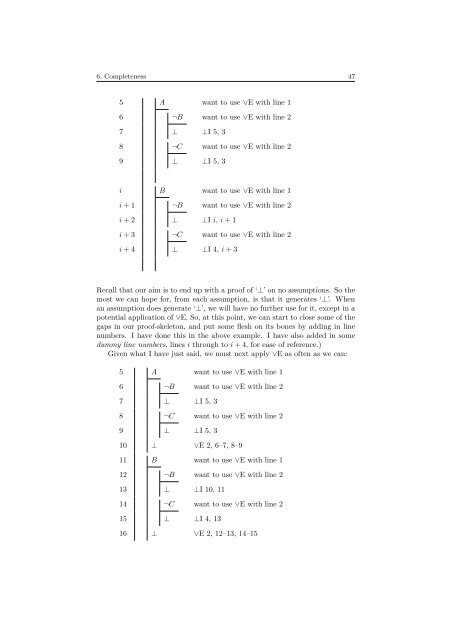Metatheory - University of Cambridge
Metatheory - University of Cambridge
Metatheory - University of Cambridge
Create successful ePaper yourself
Turn your PDF publications into a flip-book with our unique Google optimized e-Paper software.
6. Completeness 47<br />
5 A want to use ∨E with line 1<br />
6 ¬B want to use ∨E with line 2<br />
7 ⊥ ⊥I 5, 3<br />
8 ¬C want to use ∨E with line 2<br />
9 ⊥ ⊥I 5, 3<br />
i B want to use ∨E with line 1<br />
i + 1 ¬B want to use ∨E with line 2<br />
i + 2 ⊥ ⊥I i, i + 1<br />
i + 3 ¬C want to use ∨E with line 2<br />
i + 4 ⊥ ⊥I 4, i + 3<br />
Recall that our aim is to end up with a pro<strong>of</strong> <strong>of</strong> ‘⊥’ on no assumptions. So the<br />
most we can hope for, from each assumption, is that it generates ‘⊥’. When<br />
an assumption does generate ‘⊥’, we will have no further use for it, except in a<br />
potential application <strong>of</strong> ∨E. So, at this point, we can start to close some <strong>of</strong> the<br />
gaps in our pro<strong>of</strong>-skeleton, and put some flesh on its bones by adding in line<br />
numbers. I have done this in the above example. I have also added in some<br />
dummy line numbers, lines i through to i + 4, for ease <strong>of</strong> reference.)<br />
Given what I have just said, we must next apply ∨E as <strong>of</strong>ten as we can:<br />
5 A want to use ∨E with line 1<br />
6 ¬B want to use ∨E with line 2<br />
7 ⊥ ⊥I 5, 3<br />
8 ¬C want to use ∨E with line 2<br />
9 ⊥ ⊥I 5, 3<br />
10 ⊥ ∨E 2, 6–7, 8–9<br />
11 B want to use ∨E with line 1<br />
12 ¬B want to use ∨E with line 2<br />
13 ⊥ ⊥I 10, 11<br />
14 ¬C want to use ∨E with line 2<br />
15 ⊥ ⊥I 4, 13<br />
16 ⊥ ∨E 2, 12–13, 14–15
















